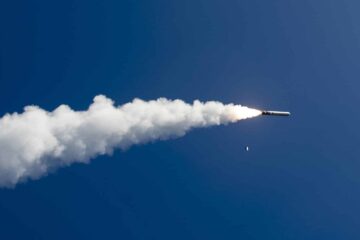But are more DDG really the best option for Japan ?
Following the decision to suspend the deployment of Aegis Ashore, Japan’s Ministry of Defense (MoD) has been considering three alternatives so far:
- Aegis system and radar fitted aboard commercial/civilian merchant ships
- Aegis system and radar fitted on offshore platforms (similar to oil rigs).
- Building additional Aegis destroyers.
Bottom: SBX Semi-submersible, self-propelled platform that provides ballistic missile-tracking information for the Missile Defense Agency.
Concerns for the first two options quickly emerged because of their low level of protection and their weakness in case of torpedo attacks and sabotage. So the procurement of additional Aegis ships is appropriate from that point of view.
However, the Aegis destroyers under consideration are fundamentally different from the existing Aegis ships that are operated by the JMSDF and US Navy. The radar on those Aegis destroyers is not the SPY-1 (which is employed by the JMSDF) nor is it the SPY-6 (which is progressively being fielded by the US Navy, aboard the DDG 51 Flight III). It is a SPY-7 radar system originally purchased for Aegis Ashore. In addition, the on-board Aegis Combat System (ACS) will also have to be retrofitted, adapted and modified into a new version for its use at sea, aboard a moving ship rather from a fixed land based location as initially planned for Aegis Ashore.
High price tag of new “Aegis Ashore Destroyers”

Aegis Ashore is, of course, operated on the ground, and therefore requires various modifications to get the system compatible with at-sea operations. For example, it must compensate for the ship’s sway, update the direction of travel and its speed, or even add anti-submarine warfare (ASW), anti-surface warfare (ASuW), electronic warfare (EW) capabilities and fire control for guns. Therefore, the cost of building an Aegis ship, combined with the cost of refurbishing and adapting the Aegis Ashore combat system, is quite enormous.
According to MoD documents released by Masahisa Sato, a member of the Japanese House of Councilors, the initial cost of these Aegis ships is estimated at 240 to 250 billion yen (about $2.4 to $2.5 billion) per ship. But this is not a definitive number and could go up or down in the future depending on circumstances. There are strong opinions from within Japan’s ruling Liberal Democratic Party (LPD) that the radar on board should be SPY-6 and the software should be BL10 to deal with multiple threat including Chinese Hypersonic Glide Vehicle (HGV) if they are going to spend this much money.
Are new Aegis Destroyers really the best option ?

Basically, the procurement of additional Aegis destroyers is positioned as a replacement for the Aegis Ashore program. But is it really so?
The purpose of the introduction of Aegis Ashore was to address the issue of continuously deploying JMSDF Aegis destroyers to the Sea of Japan against the increased ballistic missile threat by North Korea. Had Aegis Ashore been fielded, the JMSDF would then have been required to deploy JMSDF Aegis destroyers to the East China Sea and the Pacific Ocean to respond to China’s maritime expansion. However, the building of additional Aegis destroyers tends to be a response to China, rather than a response to North Korea. Indeed, Aegis Ashore was also supposed to play an indirect role in responding to China, but this role, with Aegis destroyers in play, is much more direct.
In addition, Aegis Ashore would have been cheaper to operate and easier to man, which is a major advantage compared to destroyers. Once an Aegis ship leaves port, its crew has to serve at sea for months, while with Aegis Ashore, the operators can enjoy regular breaks in town. In other words, it is a mistake to view the construction of additional Aegis ships as a simple alternative to Aegis Ashore.
Currently, the JMSDF has a manpower shortage problem, and if it were to build additional Aegis destroyers, it would have to find a crew for them one way or another. In addition, question marks remain on the performance and price of those vessels, as pointed out earlier. Considering all of these factors, it appears that the Aegis Ashore deployment plan should be re-examined again to allow more leeway for Aegis destroyer’s operation, and then respond to Chinese threats by improving the performance of existing Aegis destroyers and the Integrated Air and Missile Defense (IAMD) of the JSDF as a whole.








